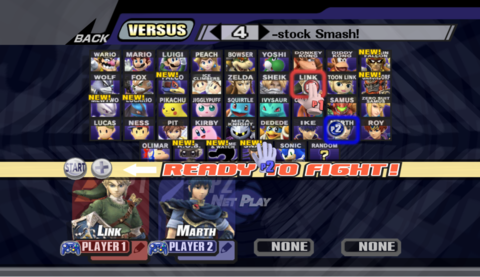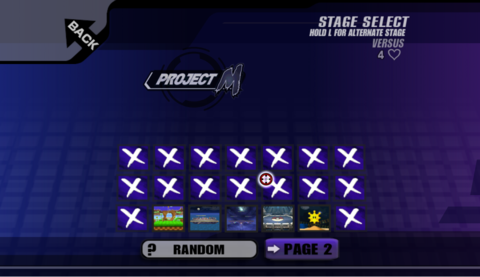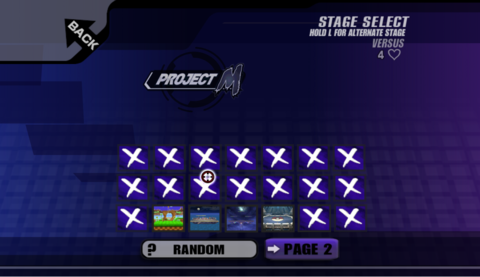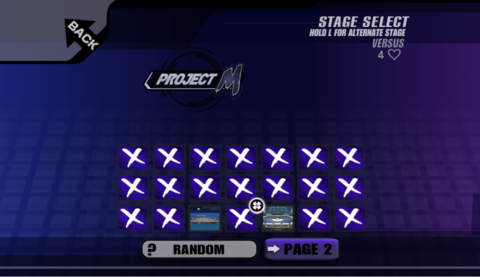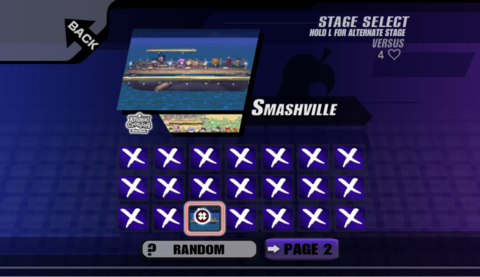Stage striking: Difference between revisions
EndGenuity (talk | contribs) m (the part about the number of stages feels repetitious) |
m (Text replacement - "== ([^=])" to "== $1") Tag: Mobile edit |
||
| (3 intermediate revisions by 3 users not shown) | |||
| Line 1: | Line 1: | ||
{{ArticleIcons|series=y|competitive=y|unofficial=y}} | {{ArticleIcons|series=y|competitive=y|unofficial=y}} | ||
'''Stage striking''' is a common procedure in | '''Stage striking''' is a common procedure in ''Super Smash Bros.'' [[tournament]]s, used to ensure the [[stage]] of a set's first match is fairly selected. Though the exact process varies depending on the number of available stages, stage striking involves starting with a list of [[neutral stage]]s, then having all players in the match take turns removing one or more stages from the list until only one stage is left. The procedure can be skipped entirely by invoking the [[Gentleman's Clause]], provided the tournament has such a rule. | ||
Stage striking operates similarly to the 1-2-2-1 setup of doubles matches. It begins with the players deciding who will strike first (such as by coin flip or {{s|wikipedia|rock-paper-scissors}}), after which one player will strike a stage, and the next will strike another stage. The process then repeats in reverse, with the player that went second striking another stage before the player that went first can strike another. This continues until only one stage is left, including the scenario in which there are fewer than five legal stages, and that stage will be used for the match. For successive matches, the loser of the previous match is allowed to select any stage among the list of [[counterpick stage]]s and neutral stages. Variations of [[Dave's Stupid Rule]] may limit which stages can be selected in | Stage striking operates similarly to the 1-2-2-1 setup of doubles matches. It begins with the players deciding who will strike first (such as by coin flip or {{s|wikipedia|rock-paper-scissors}}), after which one player will strike a stage, and the next will strike another stage. The process then repeats in reverse, with the player that went second striking another stage before the player that went first can strike another. This continues until only one stage is left, including the scenario in which there are fewer than five legal stages, and that stage will be used for the match. For successive matches, the loser of the previous match is allowed to select any stage among the list of [[counterpick stage]]s and neutral stages. In some tournament formats, such as most ''Brawl'', ''Smash 4'', and ''Ultimate'' sets, and best of three sets in ''Melee'', the previous game’s winner is allowed one or more stage bans, which prevents the loser from going to that stage(s) for the next game (but not the entire set). In best of five ''Melee'' sets, however, no stage bans are allowed for winners of the previous game. Variations of [[Dave's Stupid Rule]] may limit which stages can be selected in these cases. | ||
As {{SSB|Dream Land}} is the sole legal stage in current ''Smash 64'' tournaments, stage striking is not necessary in them, though it was previously featured in older, less restrictive rulesets for the game. | As {{SSB|Dream Land}} is the sole legal stage in current ''Smash 64'' tournaments, stage striking is not necessary in them, though it was previously featured in older, less restrictive rulesets for the game. | ||
==Example of stage striking== | ==Example of stage striking== | ||
<gallery heights="320" widths="480"> | <gallery heights="320" widths="480"> | ||
File:StageStrike1.png|Player 1 selects {{PM|Link}} and Player 2 selects {{PM|Marth}}. In this example, Player 2 is assumed to have won the coin flip, and as a result, they get to pick the first stage to be struck. | File:StageStrike1.png|Player 1 selects {{PM|Link}} and Player 2 selects {{PM|Marth}}. In this example, Player 2 is assumed to have won the coin flip, and as a result, they get to pick the first stage to be struck. | ||
| Line 15: | Line 14: | ||
File:StageStrike5.png|The Marth player gets to strike one more stage, selecting Pokémon Stadium 2 due to its slightly larger size compared to Smashville. Smashville is the last remaining stage, and so, it will be used as the first stage in this set. | File:StageStrike5.png|The Marth player gets to strike one more stage, selecting Pokémon Stadium 2 due to its slightly larger size compared to Smashville. Smashville is the last remaining stage, and so, it will be used as the first stage in this set. | ||
</gallery> | </gallery> | ||
[[Category:Terms]] | [[Category:Terms]] | ||
[[Category:Competitive play]] | [[Category:Competitive play]] | ||
Latest revision as of 00:54, April 13, 2022
Stage striking is a common procedure in Super Smash Bros. tournaments, used to ensure the stage of a set's first match is fairly selected. Though the exact process varies depending on the number of available stages, stage striking involves starting with a list of neutral stages, then having all players in the match take turns removing one or more stages from the list until only one stage is left. The procedure can be skipped entirely by invoking the Gentleman's Clause, provided the tournament has such a rule.
Stage striking operates similarly to the 1-2-2-1 setup of doubles matches. It begins with the players deciding who will strike first (such as by coin flip or rock-paper-scissors), after which one player will strike a stage, and the next will strike another stage. The process then repeats in reverse, with the player that went second striking another stage before the player that went first can strike another. This continues until only one stage is left, including the scenario in which there are fewer than five legal stages, and that stage will be used for the match. For successive matches, the loser of the previous match is allowed to select any stage among the list of counterpick stages and neutral stages. In some tournament formats, such as most Brawl, Smash 4, and Ultimate sets, and best of three sets in Melee, the previous game’s winner is allowed one or more stage bans, which prevents the loser from going to that stage(s) for the next game (but not the entire set). In best of five Melee sets, however, no stage bans are allowed for winners of the previous game. Variations of Dave's Stupid Rule may limit which stages can be selected in these cases.
As Dream Land is the sole legal stage in current Smash 64 tournaments, stage striking is not necessary in them, though it was previously featured in older, less restrictive rulesets for the game.
